“I don’t understand why you’re not more fascinated with this. I mean, we could be living next door to a murderer, Larry.”—— Diane Keaton to Woody Allen
A married couple, the Liptons (Woody Allen and Diane Keaton), live seemingly easy and carefree lives in a Manhattan apartment building. While visiting fellow residents, the Houses, the Liptons view the middle-age couple as a bit eccentric, though their ideas and pastimes—planned twin cemetery plots and a husband who collects stamps—seem conventional enough. When the Liptons return to their own apartment, Larry is indignant that Carol didn’t respond to his signals to leave. “My favorite thing in life,” he grumbles, “is, you know, to look at cancelled postage.”
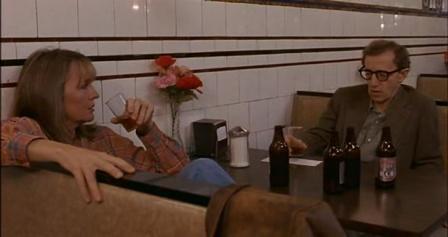 The Allen-directed Manhattan Murder Mystery, a comedy-mystery that eschews most of the angst-clouded themes of earlier Allen films, is a cinematic endeavor made more for sheer audience enjoyment, much in the vein of the director’s later Midnight in Paris (2011). Although a look into the lives of a hardly typical couple, this is actually a format for Larry’s forebodings, phobias, feelings of inferiority and vacillations. Not surprising, then, that the best lines belong to Allen.
The Allen-directed Manhattan Murder Mystery, a comedy-mystery that eschews most of the angst-clouded themes of earlier Allen films, is a cinematic endeavor made more for sheer audience enjoyment, much in the vein of the director’s later Midnight in Paris (2011). Although a look into the lives of a hardly typical couple, this is actually a format for Larry’s forebodings, phobias, feelings of inferiority and vacillations. Not surprising, then, that the best lines belong to Allen.
In Manhattan Murder Mystery, Allen the actor still plays the nerd, the eccentric, the Nervous Nelly. When the wife, Lillian (Lynn Cohen) House, dies from a reported heart attack, he fitfully discourages Carol from pursuing her suspicions that the deceased was murdered. But recruiting a reluctant Larry anyway, Carol concocts an excuse to visit Paul House (Jerry Adler), and while making coffee in his kitchen, she finds an urn, which contradicts the widower’s earlier comment that Lillian was buried in the cemetery.
 Later, Carol, alone, rummages through Paul’s apartment while he’s out and finds two airline tickets to Paris for Paul and a Helen Moss (Melanie Norris). Here the old-fashioned technique of cutting back and forth between the unsuspecting, snooping Carol and the step-by-step return of Paul somehow, after all these years, can still be suspenseful—at least in the hands of director Allen. When House does return, Carol hides under the bed and overhears a phone conversation between Paul and someone—possibly Helen Moss?
Later, Carol, alone, rummages through Paul’s apartment while he’s out and finds two airline tickets to Paris for Paul and a Helen Moss (Melanie Norris). Here the old-fashioned technique of cutting back and forth between the unsuspecting, snooping Carol and the step-by-step return of Paul somehow, after all these years, can still be suspenseful—at least in the hands of director Allen. When House does return, Carol hides under the bed and overhears a phone conversation between Paul and someone—possibly Helen Moss?
The plot won’t be new to mystery fans—it’s somewhat clichéd and predictable. The relaxed, carefree blend of romance, comedy and mystery recalls Charade (1963). The movie also has a Hitchcockian air while avoiding any direct plagiarisms, though references are made to Vertigo (1958), and a poster of the film is visible on a bus in which Carol sees the “dead” wife.
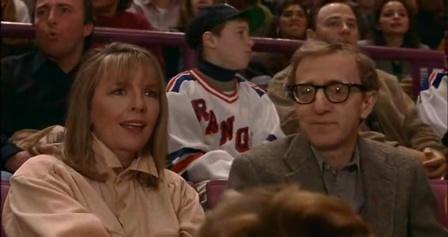 The keynote here is the chemistry between Allen and Keaton. Having well established their relationship, both off screen and in seven earlier films—Manhattan Murder Mystery is their last so far—they easily reflect, after all these years, the warmth of the film’s well-settled married couple. Now it’s the interplay of their contrasting differences—she vivacious and excitable, he passive and introverted, rather than the shared neuroses of some of their other movies. There are no torrid love scenes—they would be distracting, in the way and disruptive to the pace and theme of the film. Simple touches, the relaxed ease of the characters/stars around each other, convey all that’s necessary.
The keynote here is the chemistry between Allen and Keaton. Having well established their relationship, both off screen and in seven earlier films—Manhattan Murder Mystery is their last so far—they easily reflect, after all these years, the warmth of the film’s well-settled married couple. Now it’s the interplay of their contrasting differences—she vivacious and excitable, he passive and introverted, rather than the shared neuroses of some of their other movies. There are no torrid love scenes—they would be distracting, in the way and disruptive to the pace and theme of the film. Simple touches, the relaxed ease of the characters/stars around each other, convey all that’s necessary.
Allen’s screenplay, with Marshall Brickman, is influenced by the husband-and-wife detective team of Nick and Nora Charles in The Thin Man series, though without the teasing approach to the Charles’ drinking. While the Production Code of the ’30s and ’40s relegated Nick and Nora to twin beds, Larry and Carol freely share the same bed—now a place for suspicions, analyses and strategy regarding their neighbor.
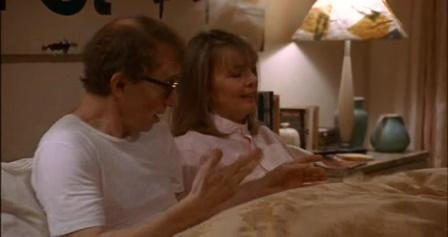 In the first of at least three bedroom scenes, Carol suggests to hubby that Paul House is just a bit too “cheerful” so soon after his wife’s death. Late one night, Carol rouses Larry from a deep sleep and leads him on another search of the House apartment. Later, they consider that maybe Paul or this woman who looks like Lillian has a twin, maybe both. Larry even suggests how the “original” Lillian might have been done it, for by now he is fully into the sleuthing—with, naturally, reservations, hesitations and excuses. “My life is passing before my eyes,” he says. “The worst part about it is that I’m driving a used car.”
In the first of at least three bedroom scenes, Carol suggests to hubby that Paul House is just a bit too “cheerful” so soon after his wife’s death. Late one night, Carol rouses Larry from a deep sleep and leads him on another search of the House apartment. Later, they consider that maybe Paul or this woman who looks like Lillian has a twin, maybe both. Larry even suggests how the “original” Lillian might have been done it, for by now he is fully into the sleuthing—with, naturally, reservations, hesitations and excuses. “My life is passing before my eyes,” he says. “The worst part about it is that I’m driving a used car.”
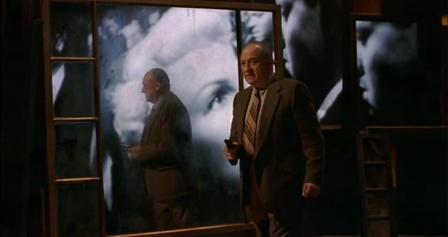 And then among the influences in Manhattan Murder Mystery there’s Allen’s movie-within-a-movie climax, a shootout in a movie theater that is showing Orson Welles’ The Lady from Shanghai (1948), the confrontation between Everett Sloane and Rita Hayworth in a hall of mirrors.
And then among the influences in Manhattan Murder Mystery there’s Allen’s movie-within-a-movie climax, a shootout in a movie theater that is showing Orson Welles’ The Lady from Shanghai (1948), the confrontation between Everett Sloane and Rita Hayworth in a hall of mirrors.
To another apartment building, Carol and Larry follow the woman Carol had seen on the bus. They find no one, only Lillian’s wedding ring. In leaving the building, they become trapped in the elevator, and when they open the emergency exit in the ceiling to escape, Lillian’s body falls out. Larry, already more than a little jittery, says, “Claustrophobia and a dead body—this is a neurotic’s jackpot!”
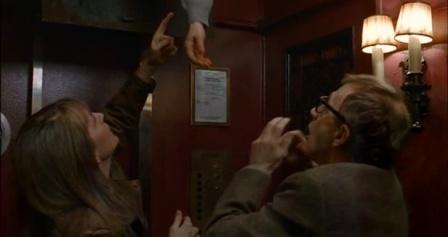 The elevator eventually operates and Carol and Larry escape. From outside the apartment, they see Paul House take the body to his car. They follow the car in their own to the city waste disposal plant, where the body ends up in a furnace. (During the car pursuit the jazz score is a little intrusive and inappropriate.)
The elevator eventually operates and Carol and Larry escape. From outside the apartment, they see Paul House take the body to his car. They follow the car in their own to the city waste disposal plant, where the body ends up in a furnace. (During the car pursuit the jazz score is a little intrusive and inappropriate.)
Carol had earlier shared her suspicions with family friend Ted (Alan Alda), who had encouraged her to pursue her investigation. Together with Larry, the three gather in a restaurant, now joined by a business associate of Larry’s, Marcia (Anjelica Huston). They all hypothesize about Paul House’s scheme and how to bring him to justice. (Here it must be admitted that the conversations go on just a little too long.)
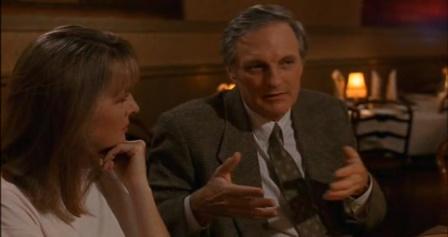 Even beyond the agile camera work of once regular Allen cinematographer, the late Carlo Di Palmer, who indeed has to be quick to keep up with the stars’ antics, the Allen trademarks continue in the jazz score, a collection of recordings representing the director’s favorite music. Many of the artists—in often famous recordings—include Errol Garner, Benny Goodman, Bobby Short, the Dave Brubeck Quartet, with their renditions of “Misty,” “Take Five,” “I’m In the Mood for Love” and the Guys and Dolls Overture.
Even beyond the agile camera work of once regular Allen cinematographer, the late Carlo Di Palmer, who indeed has to be quick to keep up with the stars’ antics, the Allen trademarks continue in the jazz score, a collection of recordings representing the director’s favorite music. Many of the artists—in often famous recordings—include Errol Garner, Benny Goodman, Bobby Short, the Dave Brubeck Quartet, with their renditions of “Misty,” “Take Five,” “I’m In the Mood for Love” and the Guys and Dolls Overture.
The attentive listener will detect a bit of Miklós Rósza’s score for Double Indemnity (1944), a tale about a wife and an insurance salesman scheming to secure the husband’s insurance money, a related theme in Manhattan Murder Mystery. And when the Liptons hear Der Fliegende Holländer at Lincoln Center, it prompts Larry to observe: “I can’t listen to that much Wagner, ya know? I start to get the urge to conquer Poland.” There are other Allen digs at Wagner and opera.
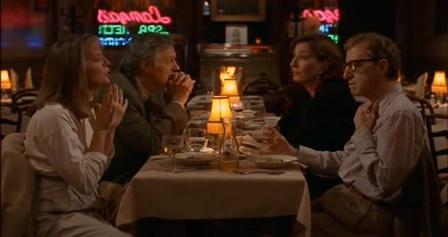 The amateur sleuths at the restaurant decide that the way to snag Paul is with a bluff. Larry telephones House, saying he has a “package he might want”—his wife’s body, in exchange for $200,000 in “small, unmarked bills,” as Larry nervously says, “or large, marked bills if you want to go that route.” House counters by saying he has Carol—her in exchange for Lillian’s body. The two men meet.
The amateur sleuths at the restaurant decide that the way to snag Paul is with a bluff. Larry telephones House, saying he has a “package he might want”—his wife’s body, in exchange for $200,000 in “small, unmarked bills,” as Larry nervously says, “or large, marked bills if you want to go that route.” House counters by saying he has Carol—her in exchange for Lillian’s body. The two men meet.
Larry cannot, of course, produce the body and flees into a movie theater that is showing The Lady from Shanghai. While Larry and Paul are stalking each other, Gladys Dalton (Marge Redmond), a former lover Paul had discarded in favor of Helen, confronts him. They mimic the original lines of Sloane and Hayworth. “Killing you is killing myself,” he says, “but, you know, I’m pretty tired of both of us. I’m aiming at you, lover.” And she responds, “I’m aiming at you, lover.” Dalton kills him, and during all this, with cuts back to Carol, Carol breaks free of her ropes and gag and escapes.
Turns out, it was Lillian’s sister (Ruth Last), a recluse who lived in the same apartment building, who had had a legitimate heart attack while visiting the Houses. Paul and Lillian saw the chance for Lillian to take her sister’s place and, as her sister, alter her sister’s will so as to make the Houses the sole beneficiaries. Paul, however, became enamored of Helen and disposed of Lillian, little anticipating the vengeance of the jilted Gladys.
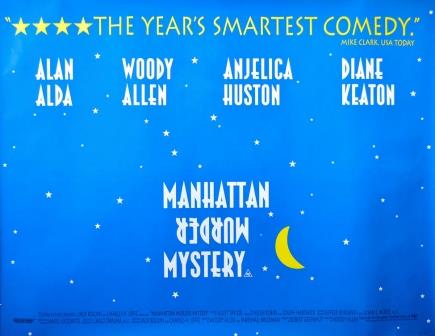
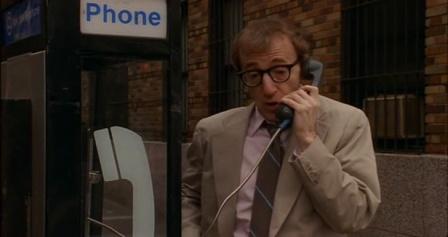
I’m trying to find a Woody Allen movie where he’s driving through a cemetery knocking over headstones trying to find a place to bury someone!